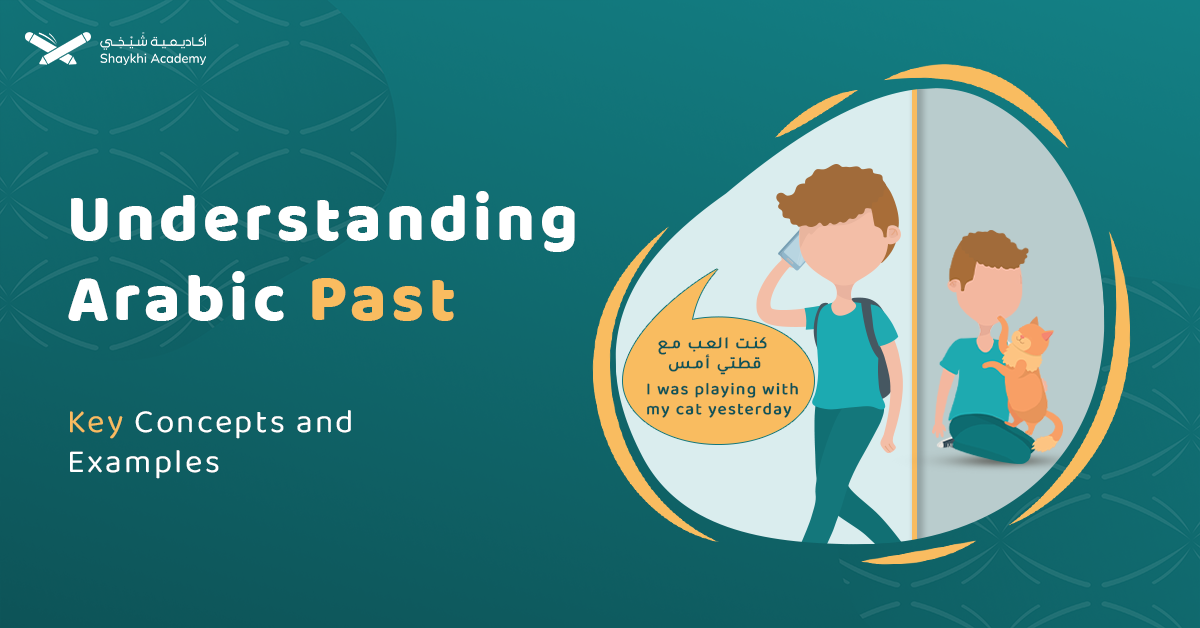In Arabic past tense, the action has already been accomplished. It stands for events, actions, and situations that started in the past time and are no longer perpetual.
The past tense provides a clear intimation that an action has reached a full completion. It is often used for reporting past experiences and stating narrated events.
In the following lines, we will shed light on the different aspects of the Arabic past tense. We will explain how you can grasp the Arabic past tense and what is the proper construction of correct Arabic past tense sentences.
How Many Tenses Does Arabic Have?
Arabian linguists agree that the tenses in the Arabic language are three tenses: the past tense, the present tense and the command tense, (Imperative). The Arabic future formula is considered as the Arabic language fourth tense as a traditional linguistic norm, not as a linguistic law.
The Arabic language contains various linguistic formulations, denoting all other tenses of all other languages. Arabian grammarians based the tenses divisions on the presence of a separate structure for the verb.
The Past tense describes completed actions, the Present conveys ongoing or current actions, and the Command is used for giving orders, always in the second person. To express future events, Arabic adds prefixes like “سـ” (sa) or the particle “سوف” (sawfa) to the Present tense. Mastering these tenses, as taught in Shaykhi Academy’s Fusha Arabic Course, is key to understanding Arabic grammar and usage.
Arabic Past Tense Verbs
In Arabic, the past tense conveys actions that began and completed in the past. It typically takes the same form as the verb root, often consisting of three to five letters (e.g., “كتب” for “wrote” or “لعب” for “played”). A second way to identify past tense verbs is by removing the first letter of the present tense form, which results in the past form (e.g., “ألعبُ” becomes “لَعبَ” for “I played”).
Past tense verbs in Arabic must be conjugated with a prefix or suffix to align with the sentence subject’s person, number, and gender. Unlike in English, these conjugations vary significantly depending on the subject and are essential for accurate sentence structure. For example, “I played” becomes “لَعَبْتُ” for a first-person singular form, while “they played” is “لَعَبُو” for a third-person plural form.
Sentence Example:
| English | Arabic | Transliteration |
| Heba drank a glass of milk | شربت هبه كوبًا من اللبن | Sharbat Heba koban men al-labn |
How to recognize the past tense verb?
There are two ways to recognize the past tense verb. Here they are:
1. The First Way to Recognize the Past Tense Verb
The verb form of the past tense is the same construction as the word root. It is often constructed of three or four or five letters. The following schedule summarizes this point.
| Word root | Past form |
| ذهب | ذهب |
| لعب | لعب |
| كتب | كتب |
| ضرب | ضرب |
| كذب | كذب |
| مشى | مشى |
| قفز | قفز |
| ضحك | ضحك |
2 The Second Way to Recognize the Past Tense Verb
The past tense verb is formed by omitting the first letter of the present tense verb; which is one of the following (أ – ن – ي – ت)
Examples
| Present مضارع | Past ماضي |
| ألعبُ I play | لَعبتُ I played |
| نمشي We walk | مَشينا We walked |
| يأكل He eats | أَكَلَ He ate |
| تنام She sleeps | نَامت She slept |
| يشاهد He watches | شاهدَ He watched |
| يشرب He drinks | شَربَ He drank |
Conjunction of the Past Verb and the Sentence Subject
There must be a conjunction between the past tense verb and the sentence subject. Unlike English, The Arabic verb doesn’t have just one single form. Instead, a specific prefix or suffix is added to the main form of the Arabic past tense verb to cope with the sentence subject as it is highly associated with the sentence syntax.
The past tense suffixes or prefixes are attached to the pasr verb. In the Arabic sentence, the pronoun who is indicating the doer of the action comes after the verb.
The prefix or suffix is mainly specified according to the person, number, and subject gender (the performer of the action). This process is called conjugation. It is a must to learn how to conjugate basic everyday verbs with the proper sentence subject and have some idea of the correct word order in a sentence.
The following schedule summarizes this point:
| Subject Pronoun | Subject Pronoun Category | Past Verb Conjugation | Meaning |
| أنا | First person singular | لَعَبْتُ | I played |
| أنتَ | Second person singular [masculine | لَعَبْتَ | You played |
| أنتي | Second person singular [feminine | لَعَبْتِ | You played |
| أنتم | Second person plural | لَعَبْتُم | You played |
| هو | Third person singular [masculin | لَعَبَ | He played |
| هي | Third person singular [feminine | لَعَبَتْ | She played |
| نحن | First person plural | لَعَبْنا | We played |
| هم | Third person plural | لَعَبُو | They played |
Here are the conjugation of the Arabic past word (sat dawn /جَلَسَ):-
I sat down / جَلَستُ
We sat down / جَلًسْنا
He sat down / جَلَسَ
She sat down / جَلَستْ
You sat dawn / جَلَسْتَ
You sat down / جَلسْتِ
You sat down / جلستم
You sat down / جلستن
They sat dawn / جلسوا
They sat down / جلسن
Arabic Past Tense Verbs List
Arabic past tense verbs are classified according to the letters number of the word root. There are four kinds of the Arabic past tense verbs. Here they are:
1. Trilateral Verb (الفعل الثلاثي):
This kind of verb has three consonants.
e.g: كتب / wrote / Ka’ta’ba
2. Quadripartite Verb (الفعل الرباعي):
This kind of verb has four letters.
e.g: أطلقَ / He launched / Atla’qa
3. Quintuple Verb (الفعل الخماسي):
The quintuple verb consists of five letters.
e.g: تعلَّمَ / learned / Ta’3la’ma
Hexagonal Verb (الفعل السداسي):
It has six letters.
e.g: استخرجَ / took out / As’ta’khr’qa
The following schedule contains the four types of the Arabic verb:
| Arabic | English | Transliteration |
| تكلم | He spoke | Ta’kalmah |
| نام | He slept | Na’mah |
| فكر | He thought | Fak’rah |
| ذهب | He went | Tha’bah |
| لعب | He Played | La’abha |
| باع | He sold | Ba’3ah |
| تعلم | He learned | Ta’3almah |
| علم | He taught | A’ alamah |
| قرأ | He read | Q’ra’ah |
| كتب | He wrote | Ka’tabah |
| ارشد | He guided | Ar’sha’da |
| جادل | He debated | Ga’da’lah |
| ناقش | He discussed | Na’qa’sha |
| اشترى | He bought | Ash’tarah |
| تنافس | He competed | Ta’na’fa’sa |
| استأجر | He rent | As’ ta’aqa’ra |
| إستيقظ | He got up | As’te’qa’tha |
| استعد | He geared up | As”ta’ad’ah |
Sentence Examples OF Past Tense in Arabic
The past tense verbs has many different forms. These forms are modified to be in harmony with different syntaxes such as, person, gender, and number.
In the following lines, we are presenting various examples for the past tense verbs:
| English | Arabic | Transliteration |
| The boy went to school. | ذَهَبَ الفَتى إلى المَدرَسَة | Tha’ha’ba al-fata Ela al-madrasah |
| The girl went to school. | ذَهَبَتْ الفَتاةُ إلى المَدرَسَة | Tha’ha’bat al-fatatu Ela al-madrasah |
| I went to school. | ذَهَبتُ إلى المَدرَسَة | Tha’ha’btu Ela al-madrasah |
| Ali and Heba went to school. | ذَهَبا علي وهبة إلى المَدرَسَة | Tha’ha’ba Ali wa Heba Ela al-madrasah |
| We went to school. | ذَهَبْنا إلى المَدرَسَة | Tha’ha’bna Ela al-madrasah |
| Kareem hit the cat. | ضَرَبَ كَريمٌ القِطَّةَ | Daraba Kareemun al-qittah |
| Nader understood the lesson. | فَهِمَ نادر الدرس | Fahima Nader al-dars |
| Fatima broke the glass. | كَسَرَتْ فاطمة الكوب | Kasarat Fatima al-kub |
| Mom cooked the food. | طَبَخَتْ الأم الطعام | Tabakhat al-umm at-ta‘am |
| I advised my brother. | نَصَحتُ أخي | Nasah’tu Akhee |
14 Forms of Past Tense in Arabic
In Arabic language, the past tense verb has 14 forms of conjugations. These various forms are based on different factors of the sentence syntax such as the person, the number and the gender.
Look carefully at the following examples. Pay much attention to the words between brackets.
| Subject | Arabic | Transliteration |
| I (First Person Singular) wrote the lesson. | كَتَبْتُ الدَّرسَ | Katabtu al-dars |
| We (First Person Plural) wrote the lesson. | كَتَبْنَا الدَّرسَ | Katabna al-dars |
| You (Second Person Singular Masculine) wrote the lesson. | كَتَبْتَ الدَّرسَ | Katabta al-dars |
| You (Second Person Singular Feminine) wrote the lesson. | كَتَبْتِ الدَّرسَ | Katabti al-dars |
| You (Second Person Dual Masculine) wrote the lesson. | كَتَبْتُمَا الدَّرسَ | Katabtuma al-dars |
| You (Second Person Dual Feminine) wrote the lesson. | كَتَبْتُمَا الدَّرسَ | Katabtuma al-dars |
| You (Second Person Plural Masculine) wrote the lesson. | كَتَبْتُمُ الدَّرسَ | Katabtum al-dars |
| You (Second Person Plural Feminine) wrote the lesson. | كَتَبْتُنَّ الدَّرسَ | Katabtunna al-dars |
| He (Third Person Singular Masculine) wrote the lesson. | كَتَبَ الدَّرسَ | Kataba al-dars |
| She (Third Person Singular Feminine) wrote the lesson. | كَتَبَتْ الدَّرسَ | Katabat al-dars |
| They (Third Person Dual Masculine) wrote the lesson. | كَتَبَا الدَّرسَ | Kataba al-dars |
| They (Third Person Dual Feminine) wrote the lesson. | كَتَبَتَا الدَّرسَ | Katabata al-dars |
| They (Third Person Plural Masculine) wrote the lesson. | كَتَبُوا الدَّرسَ | Kataboo al-dars |
| They (Third Person Plural Feminine) wrote the lesson. | كَتَبْنَ الدَّرسَ | Katabna al-dars |
Arabic Past Tense Words
The following schedule clears the Arabic past tense word compared with other tenses’ words.
| الماضي (Past) | المضارع (Present) | المستقبل (Future) | الأمر (Command) | English |
| فَهِمَ | يَفْهَمُ | سَيَفْهَمُ | اِفْهَمْ | Understood |
| كَسَرَ | يَكْسِرُ | سَيَكْسِرُ | اِكْسِرْ | Broke |
| طَبَخَ | يَطْبُخُ | سَيَطْبُخُ | اُطْبُخْ | Cooked |
| نَصَحَ | يَنْصَحُ | سَيَنْصَحُ | اِنْصَحْ | Advised |
| جَلَسَ | يَجْلِسُ | سَيَجْلِسُ | اِجْلِسْ | Sat down |
| بَاعَ | يَبِيعُ | سَيَبِيعُ | بِعْ | Sold |
| فَازَ | يَفُوزُ | سَيَفُوزُ | فُزْ | Won |
| تَسَلَّقَ | يَتَسَلَّقُ | سَيَتَسَلَّقُ | تَسَلَّقْ | Climbed |
Negation of Arabic Past Tense Words
Here are the negative form of the Arabic past word (sat dawn /جَلَسَ):-
I did not sit down / لم أجلس
We did not sit down / لم نجلس
He did not sit down / لم يجلس
She did not sit down / لم تَجْلِس
You did not sit dawn / لم تَجلَس
You did not sit down / لم تجلسي
You did not sit down / لم تجلسوا
You did not sit down / لم تجلسن
They did not sit down / لم يجلسوا
They did not sit down / لم يجلسن
Start Your Journey of Learning Arabic Past Tense With Shaykhi Academy
Let Shaykhi Academy be your companion. It will provide you with an enhanced grammatical knowledge about the affluence and abundance of the Arabic language and its various tenses.
Shaykhi Academy’s Learn Arabic Online Course suits all learners’ levels. It covers essential language syntaxes and critical skills such as reading, writing, grammar, and listening.
Shaykhi Academy’s all-inclusive curriculum provides immersive educational experiences tailored in a way that deepens the learners’ understanding.
Shaykhi Academy’s Learn Arabic Online Course provides professional educational services under the auspices of the experienced tutors Dr. Mahmoud AlAssal and Sh. Luqman ElKasabany.
All Shaykhi Academy staff are authentic tutors. They graduated from Al-azhr Ash-sharif University. They have long educational experiences in the Arabic teaching field. It is a very essential matter that you should be taught under the aegis of such quality.
Why Shaykhi Academy?
- Expert Native Tutors: Learn from highly qualified native Arabic speakers.
- Flexible Scheduling: Tailor your classes to fit your busy life.
- Affordable Learning: Access top-quality education at a price that suits you.
- Global Access: Study from anywhere in the world.
Explore Our Arabic Courses:
- Noorani Qaida: Build a strong foundation in Quranic Arabic.
- Comprehensive Arabic Courses: Master the Arabic language, from beginner to advanced levels.
- Fusha Arabic Classes: Delve into Modern Standard Arabic, the key to understanding literature, media, and formal communication across the Arab world.
- Quranic Arabic Course: Enhance your connection with the Quran by learning the language in which it was revealed.
Start Your Arabic Journey Today! Whether you’re just starting or looking to deepen your knowledge, Shaykhi Academy is here to support your journey. Book your free trial now and begin your path to Arabic mastery!

Conclusion
The basis for mastering any language is mainly based on a successful tenses acquisition. This can be done through gaining grammatical theories of Arabic tenses, especially the Arabic past tense that requires a profound understanding. Mastering Arabic past tense will enable you to master the Arabic Language professionally.
















































